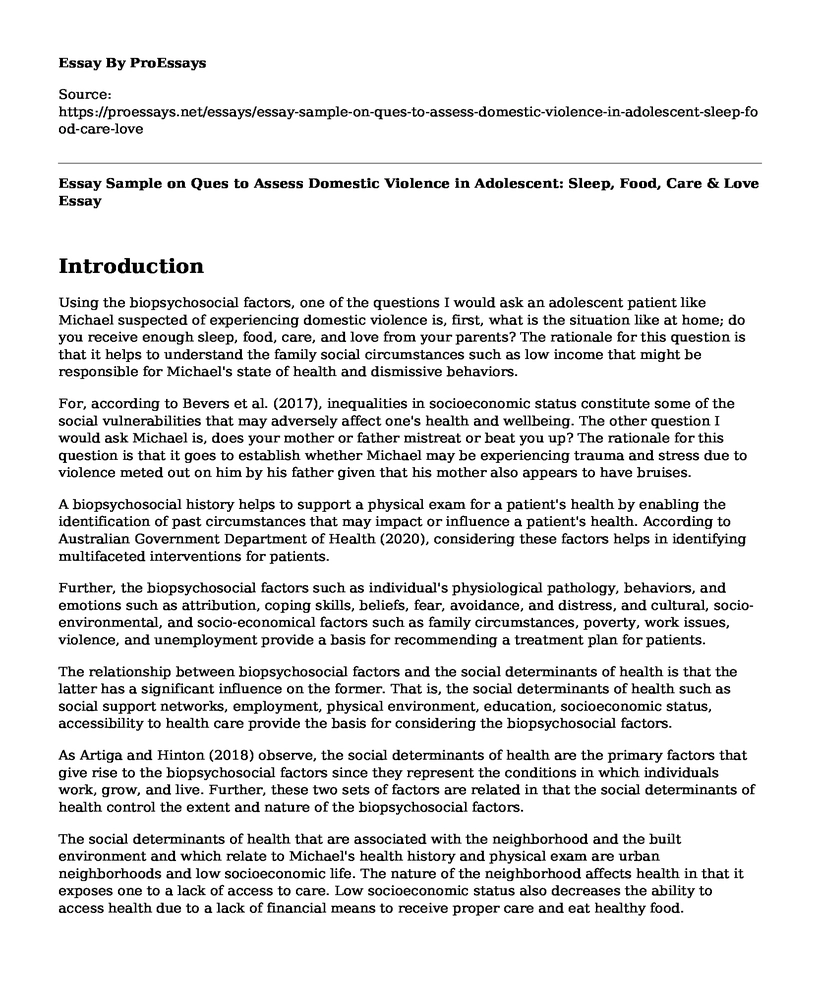Introduction
Using the biopsychosocial factors, one of the questions I would ask an adolescent patient like Michael suspected of experiencing domestic violence is, first, what is the situation like at home; do you receive enough sleep, food, care, and love from your parents? The rationale for this question is that it helps to understand the family social circumstances such as low income that might be responsible for Michael's state of health and dismissive behaviors.
For, according to Bevers et al. (2017), inequalities in socioeconomic status constitute some of the social vulnerabilities that may adversely affect one's health and wellbeing. The other question I would ask Michael is, does your mother or father mistreat or beat you up? The rationale for this question is that it goes to establish whether Michael may be experiencing trauma and stress due to violence meted out on him by his father given that his mother also appears to have bruises.
A biopsychosocial history helps to support a physical exam for a patient's health by enabling the identification of past circumstances that may impact or influence a patient's health. According to Australian Government Department of Health (2020), considering these factors helps in identifying multifaceted interventions for patients.
Further, the biopsychosocial factors such as individual's physiological pathology, behaviors, and emotions such as attribution, coping skills, beliefs, fear, avoidance, and distress, and cultural, socio-environmental, and socio-economical factors such as family circumstances, poverty, work issues, violence, and unemployment provide a basis for recommending a treatment plan for patients.
The relationship between biopsychosocial factors and the social determinants of health is that the latter has a significant influence on the former. That is, the social determinants of health such as social support networks, employment, physical environment, education, socioeconomic status, accessibility to health care provide the basis for considering the biopsychosocial factors.
As Artiga and Hinton (2018) observe, the social determinants of health are the primary factors that give rise to the biopsychosocial factors since they represent the conditions in which individuals work, grow, and live. Further, these two sets of factors are related in that the social determinants of health control the extent and nature of the biopsychosocial factors.
The social determinants of health that are associated with the neighborhood and the built environment and which relate to Michael's health history and physical exam are urban neighborhoods and low socioeconomic life. The nature of the neighborhood affects health in that it exposes one to a lack of access to care. Low socioeconomic status also decreases the ability to access health due to a lack of financial means to receive proper care and eat healthy food.
According to Healthy People (2020), this determinant of health might affect the ability to access, promote, and maintain health and wellbeing in that it makes it difficult for one to afford quality healthcare. That is, living in a poor urban neighborhood may affect access to health due to a lack of money to pay for basic needs such as healthy food and medicine.
References
Australian Government Department of Health. (2020). Assessing psychosocial factors that affect mental health. Health Australia. https://www.health.gov.au/resources/pregnancy-care-guidelines/part-e-social-and-emotional-screening/assessing-psychosocial-factors-that-affect-mental-health\
Artiga, B., & Hinton, E. (2018). Beyond healthcare: The role of social determinants in promoting health and health equity. Kaiser Family Foundation. https://www.kff.org/disparities-policy/issue-brief/beyond-health-care-the-role-of-social-determinants-in-promoting-health-and-health-equity/
Bevers, K., Watts, L., Kishino, N., & Gatchel, R.J. (2017). The biopsychosocial model of the assessment, prevention, and treatment of chronic pain. US Neurology, 12(2), 98-104
Healthy People. (2020). Social determinants of health. Office of Disease Prevention and Health Promotion. https://www.healthypeople.gov/2020/topics-objectives/topic/social-determinants-of-health
Cite this page
Essay Sample on Ques to Assess Domestic Violence in Adolescent: Sleep, Food, Care & Love. (2023, May 22). Retrieved from https://proessays.net/essays/essay-sample-on-ques-to-assess-domestic-violence-in-adolescent-sleep-food-care-love
If you are the original author of this essay and no longer wish to have it published on the ProEssays website, please click below to request its removal:
- European Refugee Crisis and How It Began Essay
- Psychosocial Considerations of Domestic and International Terrorism
- Immigration, Race, and Ethnicity in the United States Essay
- Effects of Overpopulation on the Environment Essay
- Essay Sample on A Girl's Journey: Growing Up in a Challenging World
- Essay Example on Workplace Violence: Understanding & Mitigating Factors
- Essay Example on Marcus Garvey: A Hero of African-American History







